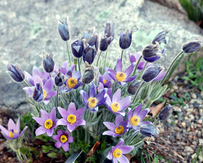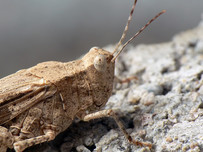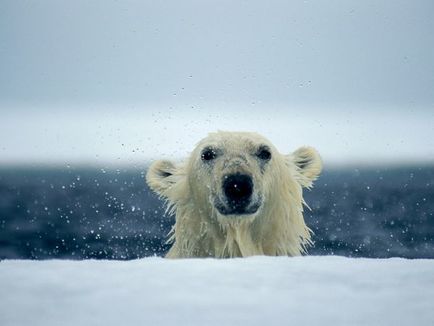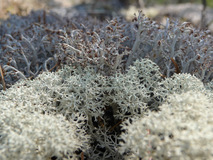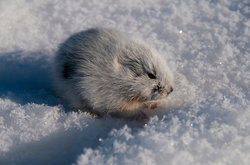BIOTIC FACTORS
Living factors within the Arctic Tundra.
Plants
Although it seems as though very few plants would be able to tolerate such harsh conditions, there are many that have been able to survive because of adaptations they have made.
Examples of plant life in the Arctic Tundra include:
Arctic Moss Calliergon giganteum
Arctic Moss is an aquatic plant that is at the bottom of lake beds, as well as in and around bogs in the Arctic Tundra. It has no roots, and instead has rhizoids. Arctic Moss grows very slowly, enabling it to use energy for conservation rather than growth. This means that the plant is able to survive longer than most other plants in the Arctic Tundra.
Bearberry Arctostaphylos uva-ursi
Bearberries are evergreen bushes only found in the Arctic Tundra. They grow low to the ground and produce leaves as well as both berries and flowers. The leaves are leathery to aid in protection from the cold and the stems are covered in thick bark and silk-like fibers for the same purpose. Bearberries often grow in dry soils such as that of the Arctic Tundra.
Arctic Cottongrass Eriophorum scheuchzeri
Arctic Cottongrass is a flowering plant that can be found growing in the Arctic Tundra. The leaves in produces are narrow, reducing transpiration, and also dark, helping with light absorption. Its seeds are held in the flowers which are easily blown away in the Tundra's harsh winds, making reproduction easy.
Pasque Flower Anemone patens
The Pasque Flower can be found on southward facing slopes in the Arctic Tundra. The plant has no leaves and consists of stems and flowers at the top of each of those stems, before it produces plums as fruit to aid in reproduction. The plant is covered in silky fibers to help insulate the plant in the cold Tundra climate.
Purple Saxifrage Saxifragia oppositifolia
Purple Saxifrage is a small, perennial, flowering shrub that can be found in the Arctic Tundra. Purple Saxifrage grows in mats along the ground and produces small flowers that are most commonly purple in colour, as well as a fruit that's seeds allow reproduction.. It has an intricate root system that enables it to respond to the changes in its environment quickly and effectively.
Animals
Herbivores
Examples of Herbivores in the Arctic Tundra include:
Caribou Rangifer tarandus
Caribou are relatives of the deer and do not live in the Arctic Tundra year-round. Instead, they migrate south to forests for protection from the harsh winters. They return to the Tundra in spring to reproduce and travel in large herds. During spring they will eat plants such as willow that grows above the surface of the ice, and during winter dig through the ice with their hooves to eat moss and lichens that lie below. They have thick coats that enable them to survive in cold temperatures.
Arctic Hare Lepus arcticus
Arctic Hares remain in the Arctic Tundra year-round without hibernation. They eat lichens, woody plants and moss during the winter which they must often dig through the snow to find, and during other seasons their diets include berries, leaves, buds and roots. Arctic Hares have long coats that are completely white during the winter and darken during warmer periods as camouflage to protect them from predators. Their ears are also small to provide them with a small surface area to volume ratio to sustain heat, and they have been known to huddle with others for warmth. They travel individually or in groups.
Lemming Lemus Lemus
The Lemming is a small rodent related to the muskrat and does not hibernate or migrate during the winter in the Arctic Tundra and instead endures the cold temperatures and harsh climate. The Lemming's diet consists of the shrubs and other small plants that grow above or below the ice surface. It has a long coat that is pure white during the winter as camouflage and darkens during other seasons for the same reason. Lemmings live alone and only get together to mate.
Rock Ptarmigan Lagopus muta
The Rock Ptarmigan is a bird found in the Arctic Tundra that remains in the Tundra even through the harsh winters but may migrate to lower lands in search of food. Its diet consists of plants and berries, as well as insects when possible. Because the several molts it does throughout the year, the colour of its feathers change to suit the season and its surrounding environment as camouflage. The feathers are thick to provide warmth and insulation in the cold.
Musk Ox Ovibos moschatus
Musk Oxen are large migratory mammals that can be found in the Arctic Tundra. They have extremely long and thick brown coats to keep them warm in the Tundra's harsh climate. They have large horns and have been known to form circles around their young as protection from predators. Their diet consists of plants and shrubs found both above and below the ice surface. They migrate to make feeding easier.
Carnivores
Examples of Carnivores in the Arctic Tundra include:
Polar Bear Ursus maritimus
The Polar Bear is the largest carnivore in the Arctic Tundra and sits at the top of the food chain. It migrates during the summer to regions where the climate is still cold. Its fur is white to camouflage it in the snow, and because of the lack of plant matter for it to eat, its entire digestive system, including its teeth are designed to eat meat. The Polar Bear's diet consists mainly of seals and other mammals.
Arctic Fox Alopex lagopus
Arctic Foxes do not hibernate or migrate during winter in the Tundra. Their bodies have adapted to survive in temperatures of down to -50°C with features such as short ears, fuzzy soles and short muzzles. The short muzzles and ears allow for a smaller surface area to volume ratio. These foxes also live in burrows which protect them from predators and harsh weather. During a blizzard, Arctic Foxes have also been known to burrow under the snow for protection. Their diet consists mainly of smaller animals such as Lemmings and Arctic Hares. The colour of their fur changes depending on seasons as camouflage.
Arctic Wolf Canis lupus arctos
The Arctic Wolf can be found in Tundra biomes such as those in North America and Greenland. In order to survive in the Arctic Tundra, the Arctic Wolf has made many adaptations such as its small ears for low surface area to volume ratio and its thick camouflaged coat. The Arctic Wolf also has fur on its paws for warmth and a thick layer or body fat. These Wolves tend to hunt in packs that have extremely large territories. The Arctic Wolf's main food sources are Musk Oxen and Arctic Hares.
Snowy Owl Nyctea scandiaca
The Snowy Owl can be found in the Arctic Tundra but is known to migrate to places south of the Arctic Circle at times. Their feathers are white and they have large claws that enable them to catch their prey. Their diet consists mainly of small rodents and rabbits in particular. Snowy Owls are the largest of the Owls in the Arctic, with a wingspan of up to 5.5 feet. Their heads can rotate in approximately 270° in each direction. This, along with their tendency to make nests on the highest land possible gives them a good perception of any approaching predators or prey.
Ermine Mustela erminea
The Ermine is one of the smallest and most ferocious carnivorous animal on the planet. They're nocturnal and live in dens in roots or in cracks between rocks. Their coat, much like many of the other animals in the Arctic Tundra changes colour depending on the season. They are solitary animals and only come together for mating. Their diet consists mainly of small rodents such as Lemmings and Voles.
Insects
Examples of Insects in the Arctic Tundra include:
Freezing-Tolerant Fly Heleomyza borealis
The Freezing-Tolerant Fly can be found in the Arctic Tundra, where it can survive temperatures down to -60°C due to its ability to survive when frozen. This Fly has a core of "'unfreezable water' usually between 10 and 30%" (Hugh V. Danks. Seasonal Adaptions in Arctic Insects [Article]. Retrieved from http://icb.oxfordjournals.org/content/44/2/85.full) that remains liquid when the rest of its internal fluids freeze around it, freezing the insect with them. The Fly will remain frozen through the winter and can survive over 4 years in the ice. When temperatures rise once again, the fly will thaw and continue living once again.
Springtail Onychiurus arctius
The Springtail's ability to survive dehydration in the winter, rather than hibernating or escaping the cold is what allows this Insect to survive in the Arctic Tundra. The vapor pressure of the water within its body is much higher than that of the ice, meaning that the water within its body is vaporised, leaving the Springtail dehydrated. To prevent freezing, the solute within the Insect must remain at a high concentration.
Arctic Woolly Bear Moth Gynaephora groenlandica
The Arctic Woolly Bear Moth itself does not live long at all, and instead lives only through the short Arctic Winter long enough to lay its eggs before dying. However, before it becomes a Moth, the Caterpillar itself is rather fascinating. It is freezing resistant, and so during the winter uses its internal liquids to create ice around itself where it remains until the weather is warm enough to thaw it out. This Caterpillar spends most of its life frozen, and so it cannot get the resources it needs to morph into a Moth. Because of its repetitive freezing, the Arctic Woolly Moth spends around 7 years as a Caterpillar.
Arctic Bumble Bee Bombus Polaris
Arctic Bumble Bees are mandatory in the reproduction of the Arctic Tundra's flora, much like they are in the rest of the world. Unlike other Bees, the Arctic Bumble Bee has a large amount of fur on its exterior, allowing it to stay warmer. It also has a habit of shuddering its wings to raise its body temperature. These bees only live short lives during the winter, but their Queen does not. Instead, she hibernates and is once again ready to reproduce when the ground warms.
Mosquito Aedes impiger
Mosquitoes in the Arctic have a short life cycle, in which the males eat nectar and the females drink the blood of other animals. During their short lives in the winter, these Mosquitoes sprawl in flowers, adjusting their body positions to absorb as much solar heat as possible to survive. These Mosquitoes without blood are able to reproduce via both facultative and obligate autogeny, however they can only produce around 6 eggs this way. When they are blood fed, they can produce around 50.
